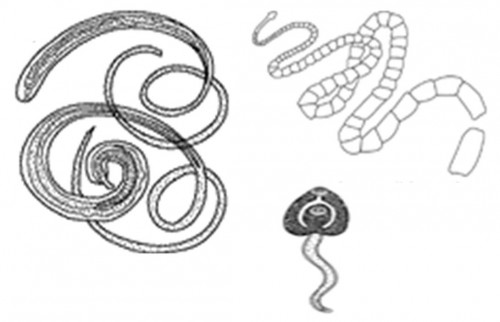
Parasites in Marine Fish
Most of the marine fish that we keep come from the wild. It isn’t unusual for these fish to have internal problems such as worms, or even bacterial or parasitic infection in their intestinal track. External parasites are also just as common, if not possible more. I have read that it is estimated that as much as 30% of the marine fish in the wild have some kind of intestinal infection.
This number can increase once they are collected for sale in the hobby as fish are kept in holding tanks along transfer points, where they can share diseases and infections. External parasites such as flukes are very common, and in my opinion, are far more common than ick. Flukes are actually a common term used to describe a number of parasites, numbering in the 100s. They can be easily transmitted between sick and healthy fish so it is always best quarantine new fish and provided a preventative treatment.
Symptoms for internal parasites can include
A) Eating good but looking like they are suffering from not getting enough nutrients and/or no signs of gaining weight
B) The appearance of losing weight
C) Loss of natural coloring
D) A unexplained loss of appetite or a change in eating habits (including completely stopping to eat)
E) Unexplained weight loss
F) The fecal matter is not darker colored, sandy, or in very small bits (but rather it is long and stringy as well as a lighter color). Normal fecal matter should look similar to a powered rather than a complete / stuck together substance.
Symptoms for external parasites can include:
A) A clear to white colored spot about 0.5 to 1.5mm in size located almost anywhere on the fish.
B) Tiny white spots on the fins or body of the fish.
C) The fish will start flashing / rubbing against objects or the bottom of the aquarium
D) Reddish looking skin and possible swelling in advanced stages
E) Secondary bacterial and fungal infections can also be common.
If left untreated, the infected fish will most likely stop eating and pass away. There are many effective treatment optional to choose from. For internal infections, longer term treatments in a quarantine tank with prazi-pro or para-guard works very well. For external parasites you should also treat in a quarantine set-up with the same meds, or complete a medicated dip following the instructions on the bottles. Although prazi pro can be safely used in a main / display tank, there are risks to doing this which you need to understand beforehand. It is also a good idea quarantine any newly purchased fish and give them a preventative treatment to “de-worm” them and help ensure this type of infection stays out of the tank. I have been completing preventative treatments while in a quarantine tank for some time now and have been successfully keeping parasites out of my display tank for a few years now
Just a word on Garlic
I have In my opinion, garlic is not a treatment option and long term use is actually harmfully to marine fish. Below are a few articles that you might find interesting on that topic.
http://www.ultimatereef.net/forums/s…5&postcount=13
http://www.reefkeeping.com/issues/2005-10/sp/index.php
http://www.ncbi.nlm.nih.gov/pubmed/15890531
The below link can help you if you have questions about setting up and using a quarantine tank set-up.
https://reefaquarium.com/2012/quarantining-new-additions/
If you have any further questions about this topic, I would suggest starting a thread in our forum (link below). If you are not currently a member, it will on take seconds to join.
http://www.aquaticcommunity.com/aquariumforum/index.php
Great write-up,